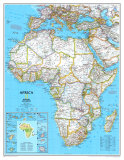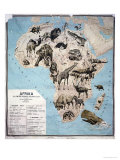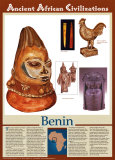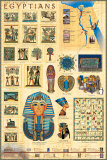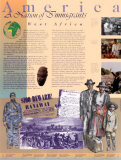|
|
Africa and African Cultures Posters, Art Prints, Charts, Maps
images for social studies, home schoolers, offices.
|
geography > AFRICA & AFRICAN CULTURES POSTERS | Africa Nat'l Parks < social studies
|
|

Africa, the 2nd largest continent on Earth, straddles the Equator and is bounded by the Atlantic Ocean on the south and west, the Mediterranean Sea on the north, connected to Asia by the Sinai Peninsula (now cut by the Suez Canal), and the Indian Ocean on the east and south. Africa at its widest point in the north stretches 4,600 mi/7,400 km, and in length 5,000 mi/8,050 km north to south. Africa contains 11,677,240 sq mi or 30,244,050 sq km, including adjacent islands: Madagascar is the largest, others include St. Helena, Ascension (S. Atlantic), Sao Tome, Principe, Annobon, Bioko (Gulf of Guinea), Cape Verde, Canary, Madeira (N. Atlantic), Mauritius, Reunion, Zanzibar, Pemba, Comoros and Seychelles (Indian Ocean).
Images include the continent of Africa from space, maps, African countries, African rainforest, deserts and parks, tribal textiles and masks, and cultures from Benin to Zimbabwe.
|
|
|

Africa Continent Poster
sorry, image
no longer available
|
Continent of Africa
Poster Text:
PHYSICAL FEATURES/CLIMATE
Many people think of Africa as all jungle, but there is ans much desert as jungle on the continent. Deserts cover two-fifths of Africa. The Sahara Desert, the largest desert in the world, stretches across 3 1/4 million square miles of northern Africa. Much of Africa is also covered by grasslands called savannas. Africa has the largest tropical area of any continent. Dense tropical rain forests surround the Congo River Basin in West Central Africa. The world's longest river, the Nile, flows for 4,145 miles through East Africa to the Mediterranean Sea. Nearly all of Africa has a hot climate, but the humidity and rainfall vary greatly. The highest temperature ever recorded, 136ºF, was in the African nation of Libya in 1922. Tropical areas can get more than 100 inches of rain a year, but the Sahara Desert averages less than 10 inches a year. Rain falls year-round in the Congo Basin, but most of the continent experiences a season of heavy rainfall followed by a dry period.
RESOURCES: Africa is a leading producer of cocoa beans, cashews, vanilla beans, and yams. Much of Africa's cultivated land is used for subsistence farming – growing local crops for the farmer and his family's own use. Africa has large deposits of diamonds, gold, copper, and petroleum, but nearly all its mineral wealth is clustered in just a few countries. Mining has played a large part in the development of Africa and accounts for more than half of its exports. South Africa is the world's leading producer of gold, and both Libya and Nigeria are leading producers of petroleum.
WILDLIFE: Africa has thousands of species of mammals, reptiles, fish, amphibians, birds, and insects. Herds of antelope, giraffes, and zebras roam the grasslands. Large cats such as leopards, cheetahs, and lions stalk these animals as prey. Some herds of elephants can still be found in the east and southeast. Chimpanezees, monkeys, and gorillas live in the forests, and hippopotamuses and crocodiles live in the tropical rivers. Because of overhunting, many of these animals are now endangered. The plant life in Africa varies greatly due to differences in climate and rainfall. Palm trees, fruit trees, and hardwoods like mahogany and ebony are found in the rain forest. Drought resistant grasses and the thick-trunked baobah tree grow on the savannas.
HISTORY/PEOPLE: The earliest evidence of human existence, dating back two million years, was found in East Africa. One of the world's first great civilizations – Ancient Egypt – sprang up along the banks of the Nile River more than 5,000 years ago. Many other empires also developed in Africa. In the 1400s, Europeans began exploring Africa and setting up trading posts. Over the next several centuries, Europeans captured Africans and shipped them to Europe and the Americas as slaves. By the 1800s, as many as 10 million Africans had been enslaved and brought to Europe and the New World. Many European nations, including Belgium, Great Britain, France, Germany, Italy, Portugal, and Spain, fought for control of Africa. By the early 1900s, these countries had made colonies af all but two nations in Africa. In the mid-1900s the demand for African independence grew and most nations were freed from European rule. The people of Africa now have various backgrounds. Some are descendents of the continent's original inhabitants, others are descended from people who came originally from Europe, East Asia, or India. There are more than 50 countries in Africa, and more than 800 languages are spoken there. Most Africans come from small ethnic groups that have their own languages and religions. In addition, Arabic-speaking Muslims are common in northern Africa, and many Christians can be found in Ethiopia and Egypt.
• Continents Poster Series
• Black History Posters
|
|
|
|
Countries of Africa-
Africa: birthplace of the human race. - The oldest human fossils, found in Ethiopia, date back more than three million years. many of the world's gretest civilizations sprang forth on this mighty continent. Egypt, Great Zimbabwe, Mali, Ghana, and more. As anthropologist Svanta Paabo says, “In a sense, we are all Africans.”
Africa: vital and exciting. - Instead of one African culture, there are many . More than 840 million people, speaking almost 2,000 languages, live in Africa's 54 different countries.
Africa: a natural paradise. - One of the most diverse and beautiful places on Earth, Africa has millions of miles of lush rainforests, majestic snow-covered mountains, broad plains, and delightful beaches. No place on earth has a wider range of animal and plant life. Africa also contains the Sahara Desert, which is so large that the entire U.S. could fit inside it.
|
|
|
|
|
|
|
|
|
|
|
|
|
The Egyptians
(3100 B.C. — 31 B. C.)
The civilization ancient Egypt was one of the most advanced, complex, and fascinating civilizations in world history. It grew up along the mighty Nile River in northeastern Africa, and lasted for more than 3,000 years. It produced some of the greatest rulers of all time, and it left behind some of the most impressive monuments ever built — including the world-famous pyramids the Egyptians constructed as tombs for their leaders.
The civilization of ancient Egypt was almost totally dependent upon the mighty Nile. The river was an important means of transportation between upper and lower Egypt, and its annual flood waters created a rich, black mud that allowed Egyptian farmers to grow many important crops. On either side of the Nilve River were scorching deserts. These deserts could make life harsh, but they also protected Egypt from attacks by invaders. Most experts say Egyptian civilization really began around 3300 B.C., when a king named Menes (MEE-neez) united the civilizations uf upper Egypt and lower Egypt. The kings of Egypt were known as pharaohs. To the Egyptians, the pharaohs were as powerful as gods. The Egyptian language was written in picture symbols called “hieroglyphics”. These hieroglyphics can be found on many of their magnificent temples and pyramids. The pyramids themselves are the oldest and largest stone structure in the world. The body of the head pharaoh was first "mummified," or preserved, and then placed in a special chamber deep inside the pyramid. Since the Egyptians believed that a pharaoh continued to rule in the afterlife, they wre buried with all their possessions, and with large amounts of gold and jewels. One of the most famous tombs was the tomb of Tutankhamen, whch was discovered in 1922. It was filled with gold and other rare treasures.
Egyptian history is divided into three periods called the Old Kingdom, the Middle Kingdom, and the New Kingdom. In between were times of turmoil the Egyptians called “illnesses.” Egypt reached its peak during the New Kingdom, which began in 1554 B.C., but around 1200 B.C., Egypt's power began to wane. Foreign invaders such as the Assyrians and Persians ruled Egypt for a time, to 332 B.C., Alexander the Great conquered Egypt. But Egyptian civilization did not really end until 31 B.C., when the Roman general Octavia defeated Cleopatra's navy and made Egypt a province of Rome. . . .
Artwork depicts one of the three great pyramids at Giza, the funeral mask of Tutankhamen, a ...... in the shape of an anhk, and a wall painting illustrating tax collection.
• more Ancient Civilizations posters
• more Egypt & Egyptian posters
• Spend the Day in Ancient Egypt: Projects and Activities That Bring the Past to Life
|
|
|
|
|
|
|
|
previous page | top
|
|
I have searched the web for visual, text, and manipulative curriculum support materials - teaching posters, art prints, maps, charts, calendars, books and educational toys featuring famous people, places and events - to help teachers optimize their valuable time and budget.
Browsing the subject areas at NetPosterWorks.com is a learning experience where educators can plan context rich environments while comparing prices, special discounts, framing options and shipping from educational resources.
Thank you for starting your search for inspirational, motivational, and educational posters and learning materials at NetPosterWorks.com. If you need help please contact us.
|
|
|




















